We recently covered the premier glucose disposal ingredient, berberine. This article focuses on a more powerful, patented form of berberine known as dihydroberberine, which is also marketed as GlucoVantage from NNB Nutrition (info@nnbnutrition.com | NNBNutrition.com).
When assessing one's health and physique goals, diet and exercise always come first. But there's another factor that tends to go neglected - nutrient partitioning. This may not necessarily be the most well-known subject in the health space, but it's gaining attention at an increasing rate as we learn the true causes of metabolic syndrome and the obesity epidemic.
Driving our food to muscle and energy usage, not fat storage
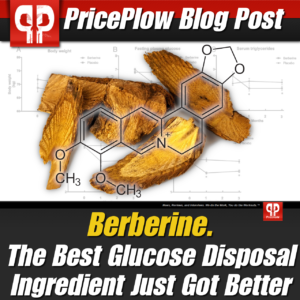
How does the best glucose disposal ingredient in berberine get any better? It's known as dihydroberberine, and sold as the patented GlucoVantage!
In simple terms, nutrient partitioning essentially explains how the body responds to the food we eat. The biggest question is how we direct and respond to our carbohydrates. Ideally, we want as many calories as we can enjoy to be used for fuel, with a significant portion going to rebuilding muscle and miniscule amounts going to fat storage. However, that's not how things always go, especially if our timing or nutrient selection is lopsided.
For instance, when we disable our fat burning mechanisms with large amounts of carbohydrates[1] and a large insulin spike,[2] the fat we eat during those times has almost nowhere to go but into storage. Sure, we can avoid much of this with low-fat or ultra low-carb diets, but perhaps we can get a best-of-both-worlds situation and allow for the flexibility, enjoyment, and benefits of both carbs and fats.
Get insulin sensitive, handle your carbs, and get back to burning fat
Insulin sensitivity is a critical component in how well our body uses nutrients and glucose. Unfortunately, it varies across all individuals, creating a need to understand optimal timing and dosing on a flexible diet. There are multiple ways to improve insulin sensitivity, and one is a supplemental ingredient known as berberine.
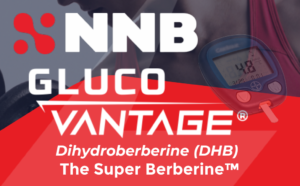
GlucoVantage from NNB Nutrition is a pure form of Dihydroberberine (DHB) and is known as "The Super Berberine". See more on NNBNutrition.com
But taking it further, there's a far more bioavailable form of this compound called dihydroberberine (DHB), coming to us in the patented GlucoVantageⓇ from NNB Nutrition. With GlucoVantage turning heads in the industry (especially for those testing blood sugar levels or wearing constant glucose monitors), it's making a very strong case as the best glucose disposal agent (GDA) ingredient available.
Read on for more on what makes dihydroberberine so special - what it is, where it comes from, and what makes it superior to other alternatives. We'll also discuss NNB's patented GlucoVantageⓇ, the industry's first commercially available DHB supplement!
Before we get into the details, please make sure you're subscribed to PricePlow so we can keep you informed on this specific topic:
Subscribe to PricePlow's Newsletter and Alerts on These Topics
Note: The following section is about insulin and insulin sensitivity/resistance. If you're familiar with these topics, you can skip right to the berberine or specific dihydroberberine sections.
What exactly is "insulin sensitivity"?
Before we can really get into the specifics of GlucoVantage, we need to first understand the system it affects.
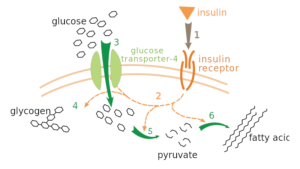
1: Insulin binds to its receptor, 2: activating various protein cascades, including translocation of GLUT4 transporter to the plasma membrane. 3: The influx of glucose. 4: The synthesis of glycogen. 5: Glycolysis. 6: Triglyceride synthesis. Image courtesy Wikimedia.
Insulin is one of the most important hormones within the body, as it essentially acts as a "motor" for the transport of nutrients within the blood. When the body senses the presence of glucose within the bloodstream, the pancreas secretes a corresponding amount of insulin to move the sugar to cells,[3] effectively lowering blood sugar levels. Because of this, insulin can be considered to be the "energy storage hormone".
Insulin powers GLUT4, the body's primary glucose transport, which eventually moves and stores glucose into fat and muscle cells.[4,5] This ultimately dictates what happens with the stored sugar - storage in fat cells yields new fat tissue, whereas storage in muscle cells yields new muscle tissue or muscle cell expansion.
Where glucose ends up depends on a number of factors, perhaps the most important being one's insulin sensitivity. Insulin sensitivity is a term for how well the body responds to insulin. If one has high insulin sensitivity, then the cells cooperate extremely well and only need a small amount of insulin to effectively lower blood glucose levels. In this case, we hope the blood sugar is directed towards muscle.
Insulin resistance: The enemy of good health
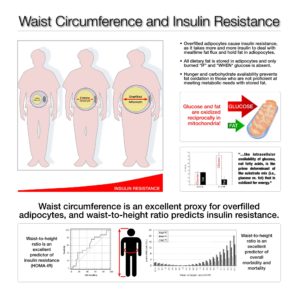
You can consider insulin resistance to mean "sugar saturation" - at some point, overfilled adipocytes refuse to store more energy. Waist-to-Height ratio makes for an excellent proxy to insulin resistance. Image courtesy Dr. Ted Naiman.
Alternatively, if insulin sensitivity is low, then the body needs to make more insulin than it would normally have to. Low insulin sensitivity, also known as insulin resistance, can be extremely problematic. When the body must produce a lot of insulin, it enters a state of elevated insulin levels. Called hyperinsulinemia, this bodily state has been linked to a mess of undesirable things, such as obesity, heart disease, diabetes, and hypertension.[6] Those aren't exactly things that are conducive to good health, making maintaining effective insulin responses critical.
There are a couple of ways one can manage insulin sensitivity. Research has shown that both aerobic and anaerobic exercise can improve insulin response,[7,8] with weight training (a form of anaerobic exercise) actually leading to an increase in muscle mass thanks to the more efficient response.[8] Getting better sleep and keeping stress levels low can also lead to improved insulin sensitivity,[9,10] suggesting that an earlier bedtime can go a long way in terms of glucose uptake!
Now, what does this all mean? Well, high insulin sensitivity not only makes it easier for the body to shuttle glucose to muscle cells (as opposed to fat cells), but it also helps avoid some serious health issues in the long-run. This makes logical sense: train hard and give your body a good place to put that sugar, or let it eventually become fat and/or toxic.
Insulin Resistance = "Sugar Saturation"
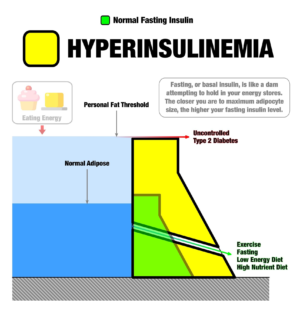
Another great image from @TedNaiman, this demonstrates what happens once your fat stores rise up (in the blue) and hit your personal fat threshold - nowhere to go but blood sugar toxicity / diabetes! The way out is with less carbs and/or more muscle via weight training and HIIT... but GlucoVantage can help too!
Meanwhile, low insulin sensitivity increases various health risks, while also making it very difficult to gain lean mass and/or lose body fat. Fat burning simply won't happen when insulin levels are elevated,[2] and insulin levels aren't going to go down if your body can't shove all of this sugar into any cells anymore! You are at the point of "sugar saturation".
Sadly, you can have all those factors of your life in check, too - a "balanced" diet, exercise, low stress, and a full 8 hours each night - and still have issues with insulin. Thankfully, there's another way you can get a little bit of extra help!
Berberine for better insulin sensitivity
Research is demonstrating dihydroberderine to be a superior form of berberine, but before we get into its specifics, allow us to briefly cover its predecessor.
One of the most promising compounds that's been used to increase insulin sensitivity is berberine. This alkaloid has a long history filled with different uses. It was originally used in Traditional Chinese Medicine as an anti-inflammatory,[11] though, more recently, science has identified some more intriguing capabilities.
The plus side of berberine
Berberine has been shown to directly interact with adenosine mono-phosphate kinase (AMPK), a protein that plays a key role in regulating energy balance.[12] AMPK activity is felt in various bodily processes, including those relevant to insulin sensitivity. In fact, berberine has been shown to increase AMPK activity, which can enhance insulin sensitivity.[13] There's a ton of research out there on berberine, most of which reaching encouraging conclusions:
-
Berberine increases adiponectin,[15] a protein secreted by fat cells that influences insulin reception on a cellular level. Further research has found that this increase in adiponectin improves insulin sensitivity![16]
- If the liver and muscle cells are adequately filled, berberine can increase glucose uptake into fat cells.[17] This lowers blood sugar, and helps resist ailments related to chronic blood sugar elevation. We of course still prefer to train hard, keep the muscles primed, and put it there instead. But realize that fat storage (and even obesity) is protective against the alternative of chronic hyperglycemia.
- Berberine supplementation has improved multiple markers of insulin sensitivity in research. Studies have found that the ingredient can lower blood glucose, hemoglobin, triglycerides, and cholesterol.[18]
- In research regarding type 2 diabetics, berberine actually improved blood glucose uptake better than metformin,[14] a leading diabetic drug! If this doesn't convey just how promising this ingredient is, then we don't know what will!
Regardless of which markers you look at - glucose levels, adiponectin levels, plasma triglycerides, etc. - berberine has shown that it can be used to improve insulin sensitivity, especially in those who desperately need its help. However, there are some serious drawbacks that make berberine supplementation troublesome.
The negatives of berberine - poor quality and poor bioavailability
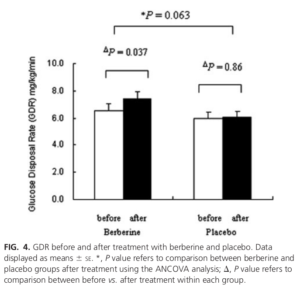
It's not called a "glucose disposal agent" for nothing! Berberine improves the overall glucose disposal rate![19]
There are two main disadvantages inherent with berberine supplementation. First, getting real, pure berberine is incredibly expensive and difficult. As such, the market for berberine is highly volatile - in 2015, formulator Shawn Wells tested 40 different berberine supplements and found that only three were pure berberine, with the other 37 being underdosed or spiked! In other words, most of the berberine available isn't the real deal!Even if you're dealing with the 100% pure berberine, there's a second snag - berberine has notoriously terrible bioavailability. Many studies have had to use massive doses of berberine to yield encouraging results, and in those same studies, there have been multiple instances of serious gastrointestinal discomfort.[14] So, not only do you have to pay a pretty penny for berberine, but you won't absorb it all, and it may also cause some stomach issues, too!
Thankfully, there's a way to get all of those benefits without running into those problems!
Note: The following section now focuses on GlucoVantage / dihydroberberine. For more info on berberine itself and coverage of the research cited above, see our main Berberine article or our video with Shawn Wells below.
Dihydroberberine to the rescue!
Now, we can finally get to what makes GlucoAdvantageⓇ special - dihydroberberine (DHB).
A derivative of berberine, DHB is one of 17 metabolites the parent compound breaks into during its life cycle within the body.[20] However, the chemical structure of DHB gives it an incredible advantage - DHB is easily absorbed into the intestine, where its then oxidized back into berberine and sent into the plasma![20] GlucoVantage acts as the "elusive spy" in your favorite thriller movie - it slips through barriers with ease, doing the work of the good guys behind enemy lines!
With standard berberine, we lose out due to lower bioavailability, and only some of it gets converted to dihydroberberine to pass through the gut. This inefficient conversion process yields much less resultant berberine than what was initially consumed, meaning that you need to consume larger amounts of it. By starting with DHB, you're effectively skipping that first step, taking less overall product to get the same final yield!
Five times more bioavailable!
Research has validated this bioavailability advantage, too. In 2015, scientists compared oral DHB to berberine, at doses that would amount to an equivalent final product. In vitro, they found that the intestinal absorption rate of dihydroberberine was five times higher than berberine.[20] These findings were then tested in practice on mice, and the researchers found that DHB was better absorbed than berberine, including in the mice lacking the necessary intestinal bacteria needed to break down berberine.[20] Not only is DHB better received by the body, but the limiting factors of berberine don't apply to DHB!
We dug into these findings and the mechanism behind them in our article titled 5x More Bioavailable: Why Dihydroberberine is "The Better Berberine". Read that article to learn even more about the specifics and how dihydroberberine is better for those with poor gut health -- which is oftentimes the people who need berberine to work best in the first place!
Dihydroberberine is just as effective!
Thanks to researchers from Australia, we're actually able to directly compare the insulin-related effects of DHB and berberine! Using mice, the scientists formed two groups - one group received 560mg/kg daily of berberine, while the other was given 100mg/day of DHB. They found that the dihydroberberine group had significantly improved markers of adiposity and triglyceride build-up compared to the berberine group, while also having a 44% increase in insulin sensitivity.[21]
Lower dose, better results
At a much lower dose, dihydroberberine actually yielded better results than berberine. Considering that DHB also carries some benefits in terms of fatty acid absorption and cardiovascular health,[22,23] the results speak for themselves - DHB (and thus GlucoVantage) is a far superior ingredient for insulin sensitivity than berberine!
DHB is easier on the stomach, though it still may give some discomfort
One thing to note: while DHB is more effective and more bioavailable than berberine, some of the stomach issues of berberine may still play a factor here. While multiple studies have found that DHB causes less severe stomach issues,[20,21] a review of the two ingredients suggests that stomach discomfort may still occur due to their interactions with the digestive system.[24] That being said, transdermal dihydroberberine has been explored because it can avoid the digestive system altogether, though it's shown to be less effective than oral DHB.[24]
GlucoVantageⓇ - the industry's first DHB supplement!

GlucoVantage from NNB Nutrition is a pure form of Dihydroberberine (DHB) and is known as "The Super Berberine". See more on NNBNutrition.com
NNB Nutrition is one of the world's leading supplement ingredient developers, known for continuously pushing the boundaries of innovation and novelty. With a footprint in over 10 countries and a portfolio that includes hundreds of formulations, NNB is truly a global force in the supplement industry. Their most popular ingredients fall under four product series - Prime Series, Truseed Series, Burn Series, and Vantage Series.

NNB Nutrition is an innovative ingredient development company with an elite team of over 100 scientists from over 10 countries.
We've previously talked about how much we love the L-BAIBA-powered MitoBurn, part of their Burn Series, but here, our focus is on the insulin sensitivity-boosting GlucoVantageⓇ. Part of the Vantage Series, GlucoVantageⓇ is the industry's first commercially available DHB supplement, made of 100%, non-GMO, natural dihydroberberine derived from Berberis aristata. It's patented[25] and NNB gets it from pure berberine.
GlucoVantage is also free of any adulteration or spiking, with lab tests available to supplement formulators, so you can trust that you're getting the real thing here as well! This formulation is constructed to deliver the insulin sensitivity and glucose disposal advantages seen in berberine, without the drawbacks or high number of capsules!
GlucoVantage in one minute
Listen to Mike talk about GlucoVantage in this quick one-minute video:
In our testing, there's no doubt that it works. Just watch our review of a supplement that contained GlucoVantage inside:
NNB has really given the supplement industry something special with GlucoVantageⓇ. Glucose Disposal Agent supplements are growing increasingly popular, with more and more people looking for ways to effectively partition nutrients as a way of amplifying their muscle-building or fat-loss efforts. Showing to be one of the top glucose uptake enhancers available, we'd expect GlucoVantageⓇ will be something brands look to when they're searching for ways to implement or improve their GDA supplement!
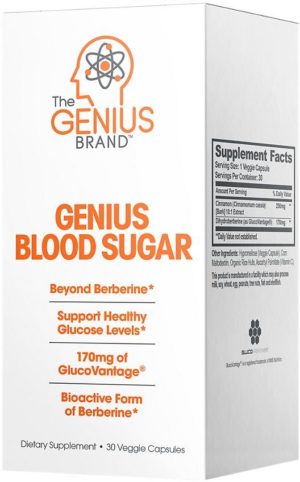
How does one avoid the berberine bioavailability problem? With dihydroberberine, as The Genius Brand figured out!
Dosing
GlucoVantageⓇ is a single-ingredient product, containing pure, unadulterated DHB. Many supplements may contain other ingredients, and formulators are free to choose how much to include in their label.
However, NNB Nutrition has extrapolated a suggested dose based on existing research, recommending one serving of GlucoVantageⓇ as 100mg to 200mg, recommending one to three servings daily. By splitting up a day's worth of this effective ingredient, you can keep more dihydroberberine (and thus more berberine) in the bloodstream, prepping you for the glucose to come and getting it where you want it to go!
It's also suggested that GlucoVantageⓇ be taken before meals, as is the case with most GDAs. In doing so, you're priming the body for the nutrients it's about to receive, setting it up for success in keeping your blood sugar levels low and your fitness goals in reach!
Potential synergy with the other products in the Vantage Series!
GlucoVantageⓇ is a versatile, supplement, as it can be incorporated in various diets of individuals with different goals. The benefits of GlucoVantageⓇ are relevant to many, including those following low-carb diets.
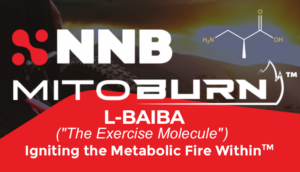
NNB Nutrition has finally brought us a trusted and tested form of L-BAIBA called MitoBurn, which we call an "exercise signal" that kickstarts incredible metabolic processes!
NNB actually offers two other supplements engineered specifically for such dieters - KetoVantageⓇ and C8VantageⓇ. KetoVantageⓇ is a potent exogenous ketone salt ingredient, built to fuel the brain, improve mental clarity, and maintain stronger levels of ketosis. C8VantageⓇ is an incredibly high-quality medium-chain triglyceride (MCT) formula, supplying ample amounts of fast-acting fuel that can power the brain and training efforts.
Meanwhile, there could be great synergy with MitoBurn L-BAIBA to "amplify" exercise efforts as well as CaloriBurn grains of paradise extract, which increases metabolic rate and activates our brown fat - the thermogenic type of fat that uses energy.
NNB is on to big things, but we do believe GlucoVantage is the best of the bunch. As Shawn Wells states in the video embedded up top, everyone needs to try a quality form of berberine at some point!
Sign up for our alerts below on GlucoVantage and we'll notify you with any news on this ingredient:
Subscribe to PricePlow's Newsletter and Alerts on These Topics
Conclusion - GlucoVantageⓇ is just getting started, and it's here to stay!
The supplement industry thrives on innovation. Berberine seemed like an unbeatable ingredient... but now it's been perfected.
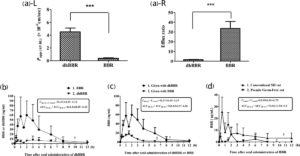
Simply put by the researchers: "DhBBR [Dihydroberberine] has a better intestinal absorption than BBR."[20]
Consistently pushing forward is what yields more effective products, better formulas, better flavoring systems, and even new brands. Without the desire to innovate, we'd stagnate, never knowing if potential improvement were attainable.NNB Nutrition may not be the name you see on the shelves in your local supplement stores, but they're surely a key cog in the industry machine. They've come out from behind the scenes to show exactly how good they are at building ingredients, and GlucoVantage is far and away the best showcase of that skill.
Building their business behind the principle of true innovation, NNB has continued to push boundaries, creating new and improved ingredient formulations that have allowed other brands to enhance their products. NNB does the science-heavy work behind-the-scenes, taking great pride in the potency and popularity their ingredients have throughout the sports supplement world.
In GlucoVantageⓇ, that narrative is only strengthened. NNB has created the industry's first dihydroberberine formulation, introducing it and it's insulin sensitivity-boosting properties into the lives of consumers everywhere. Absorbed up to five times faster than its predecessor, berberine, while also being easier to digest and just as effective, GlucoVantageⓇ is truly a game-changing ingredient. If you've been on the prowl for an effective GDA, or are simply looking for a way to enhance your insulin sensitivity, GlucoVantageⓇ might just be your best option!
Alpha Lion Gains Candy GlucoVantage – Deals and Price Drop Alerts
Get Price Alerts
No spam, no scams.
Disclosure: PricePlow relies on pricing from stores with which we have a business relationship. We work hard to keep pricing current, but you may find a better offer.
Posts are sponsored in part by the retailers and/or brands listed on this page.
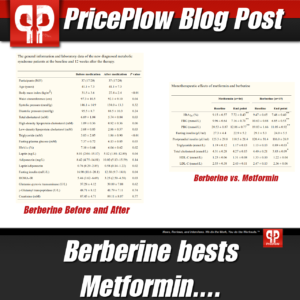
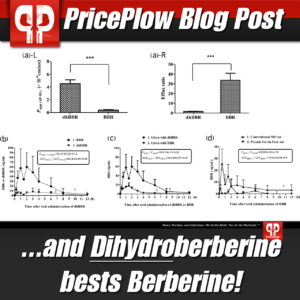
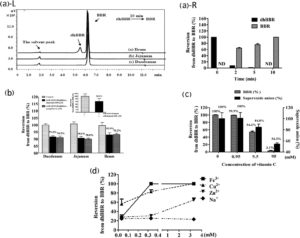


Comments and Discussion (Powered by the PricePlow Forum)